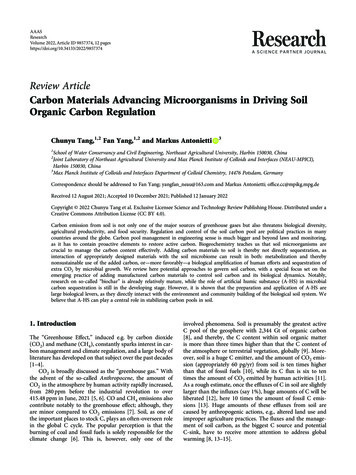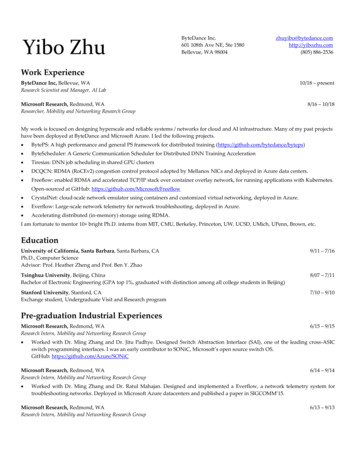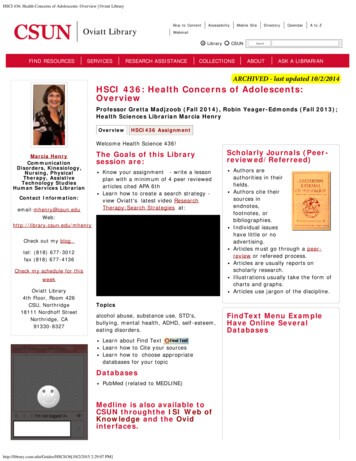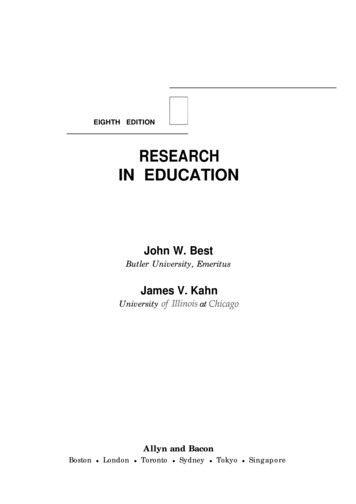
Transcription
AAASResearchVolume 2022, Article ID 9857374, 12 pageshttps://doi.org/10.34133/2022/9857374Review ArticleCarbon Materials Advancing Microorganisms in Driving SoilOrganic Carbon RegulationChunyu Tang,1,2 Fan Yang,1,2 and Markus Antonietti31School of Water Conservancy and Civil Engineering, Northeast Agricultural University, Harbin 150030, ChinaJoint Laboratory of Northeast Agricultural University and Max Planck Institute of Colloids and Interfaces (NEAU-MPICI),Harbin 150030, China3Max Planck Institute of Colloids and Interfaces Department of Colloid Chemistry, 14476 Potsdam, Germany2Correspondence should be addressed to Fan Yang; yangfan neau@163.com and Markus Antonietti; office.cc@mpikg.mpg.deReceived 12 August 2021; Accepted 10 December 2021; Published 12 January 2022Copyright 2022 Chunyu Tang et al. Exclusive Licensee Science and Technology Review Publishing House. Distributed under aCreative Commons Attribution License (CC BY 4.0).Carbon emission from soil is not only one of the major sources of greenhouse gases but also threatens biological diversity,agricultural productivity, and food security. Regulation and control of the soil carbon pool are political practices in manycountries around the globe. Carbon pool management in engineering sense is much bigger and beyond laws and monitoring,as it has to contain proactive elements to restore active carbon. Biogeochemistry teaches us that soil microorganisms arecrucial to manage the carbon content effectively. Adding carbon materials to soil is thereby not directly sequestration, asinteraction of appropriately designed materials with the soil microbiome can result in both: metabolization and therebynonsustainable use of the added carbon, or—more favorably—a biological amplification of human efforts and sequestration ofextra CO2 by microbial growth. We review here potential approaches to govern soil carbon, with a special focus set on theemerging practice of adding manufactured carbon materials to control soil carbon and its biological dynamics. Notably,research on so-called “biochar” is already relatively mature, while the role of artificial humic substance (A-HS) in microbialcarbon sequestration is still in the developing stage. However, it is shown that the preparation and application of A-HS arelarge biological levers, as they directly interact with the environment and community building of the biological soil system. Webelieve that A-HS can play a central role in stabilizing carbon pools in soil.1. IntroductionThe “Greenhouse Effect,” induced e.g. by carbon dioxide(CO2) and methane (CH4), constantly sparks interest in carbon management and climate regulation, and a large body ofliterature has developed on that subject over the past decades[1–4].CO2 is broadly discussed as the “greenhouse gas.” Withthe advent of the so-called Anthropocene, the amount ofCO2 in the atmosphere by human activity rapidly increased,from 280 ppm before the industrial revolution to over415.48 ppm in June, 2021 [5, 6]. CO and CH4 emissions alsocontribute notably to the greenhouse effect; although, theyare minor compared to CO2 emissions [7]. Soil, as one ofthe important places to stock C, plays an often-overseen rolein the global C cycle. The popular perception is that theburning of coal and fossil fuels is solely responsible for theclimate change [6]. This is, however, only one of theinvolved phenomena. Soil is presumably the greatest activeC pool of the geosphere with 2,344 Gt of organic carbon[8], and thereby, the C content within soil organic matteris more than three times higher than that the C content ofthe atmosphere or terrestrial vegetation, globally [9]. Moreover, soil is a huge C emitter, and the amount of CO2 emission (appropriately 60 pg/yr) from soil is ten times higherthan that of fossil fuels [10], while its C flux is six to tentimes the amount of CO2 emitted by human activities [11].As a rough estimate, once the effluxes of C in soil are slightlylarger than the influxes (say 1%), huge amounts of C will beliberated [12], here 10 times the amount of fossil C emissions [13]. Huge amounts of these effluxes from soil arecaused by anthropogenic actions, e.g., altered land use andimproper agriculture practices. The fluxes and the management of soil carbon, as the biggest C source and potentialC-sink, have to receive more attention to address globalwarming [8, 13–15].
2Carbon loss from soil does not only hold important ramifications for global climate change but also has massiveeffects on global food security [16, 17]. It was claimed thatthe world will face a severe food crisis unless food production is increased by 60 110% from 2005 to 2050 [16], whileat the same time, arable soil fertility is constantly decreasingdue to overfarmed land substantially losing soil organic matter (SOM) and the essential nutrients that adhere to SOM[18]. Previous investigations have revealed that SOMdepletes for various reasons, e.g., soil erosion due to largescale reclamation [17, 19], improper plowing, and excessiveuse of fertilizers [20–22], even a warming climate. Consequently, new techniques that enable to reenrich soil carbonhave to become first priority in worldwide science to easethe food, and climate crisis that will occur in the future hasalready started.To date, the investigations regarding the support ofartificial carbonaceous substances, e.g., biochar or humicsubstance (HS), to soil C pool, are advancing [23]. Suchchemical engineering processes can complement reasonablefarming systems, such as no tilling, mulching, and crop rotation [18, 24, 25]. The resilience of artificial carbonaceoussubstances against metabolization is considered critical tobuilding up stable C pools in soil [26–29]. As a base of a possible biological nonlinear amplification of carbon sequestration, biochar and HS also increase/support plant growthinducing intensified photosynthesis which sequesters moreCO2 from atmosphere [26, 30]. Additionally, there is growing focus regarding the importance of artificial carbon materials, e.g., biochar and A-HS, supporting and reinforcing thegrowth, metabolism, and community structure of microbesin soil [31, 32]. Microbial C sequestration has, in our opinion, the greatest potential for carbon fixation because ofthe various and complementary autotrophic C sequestrationschemes [33–37].Overall, the main objects of the review are to analyze thefeasibility of enhancing soil C sequestration via microbialcommunities and dissect the effect of artificial carbon materials on microecological management, with some focus onA-HS synthetized by our group [38].2. Soil Carbon FluxDerived from MicroorganismsIt is well known that microorganisms in soil both emit andsequester C. C emission from soil is in the form of CO2 inmany cases, labeled as total soil respiration (RS ), coveringbiological and nonbiological processes. Rs is the largestCO2 flux from soil to atmosphere and is constantly increasing over recent years [39], while microorganisms and theirdiversity have a vital role in soil respiration [40]. The production of methane (CH4) and its aerobic/anaerobic oxidation (CH4 CO2 ) is another path for soil microbes toparticipate in soil C emission [41].Correspondingly, C sequestration refers to the transformation of atmosphere CO2 into soil organic matter. Microorganisms are also involved in C fixation throughanabolism, besides emitting CO2 through respiration [34],and thereby start the soil C cycle [42–44]. Microbial necro-Researchmass critically contributes to soil C flux and accumulatesas SOM [45]. In the following paragraphs, the main fivepathways of microorganism to participate in soil C circulation will be reviewed.2.1. Microbial Involvement in Carbon Emissions2.1.1. Carbon Dioxide Emissions by Microbial Respiration.The biological processes of soil respiration mainly containmicrobial, root, and soil animal respiration [46, 47]. A largestock of investigations validates that microbial heterotrophicrespiration (RH ) decomposing soil organic matter (SOM)and plant debris [48] largely contribute to soil respiration[49, 50], under both aerobic and anaerobic conditions. Therate at which microorganisms oxidize and decomposeorganic matter in the presence of oxygen is unquestionablyhigh. The role of anaerobic respiration on CO2 emission isalso important; although, the flux of CO2 can be 10 timesslower than that of aerobic respiration [51]. For example,Fe- (III-) reducing microorganisms are a typical model ofanaerobic respiration. The microbes/microorganisms utilizeFe (III) as an electron acceptor, labeled as Fe respiration(Figure 1) [52, 53]. This process contributes to the mineralization of organic C on a scale of up to 44% in soils that suffer of consistent redox fluctuations [54]. Bond-Lambertyet.al [49, 55] revealed in a detailed and various insight thatthe critical rise of RH is responsible for most of the CO2 flux.RH is moreover sensitive to the rise of temperature, whichstarts a fatal cycle, i.e., excess soil C emission makes the climate warm [13], while a warming climate improves RH [56].As one example, the response of microbial respiration towarming climate was investigated by Nottingham et.al.[57] through burying warming rods in a tropical forest onBarro Colorado Island, Panama. Compared with soil at anambient temperature, the overall soil profile was warmedby 4 C over two years, resulting in a 55% increase in CO2emission originating from heterotrophic respiration. At thesame time, rainfall, soil erosion, the amount of minerals,etc., are also considerably critical for RH [13, 58–61].2.1.2. Methane/Carbon Monoxide Emissions. Methanogenesis is another anaerobic respiration path. Statistically, theemission of methane (CH4) has increased up to 1800 ppbv[62], which is approximately three times the value at thebeginning of the industrial period. Methane (CH4), whichis generated by methanogenes mainly existed in anoxic soilenvironments, e.g., paddy soils [63], is another major greenhouse gas [64, 65].In general, soil methanogens produce CH4 along threepathways (Figure 1). The first one is called CO2 reductionpathway, and it contributes 10-30% to the CH4 production[66]. During this reaction, CO2 and H2 are produced byhydrolysis and fermentation, which is induced by eitherhydrolytic or fermentative microflora (syntrophs) and utilized by hydrogenotrophic methanogen to generate CH4[37]. The second way is the acetate pathway 1 and is responsible for 70-90% of CH4 production [66]. In this process,acetate is produced by fermentation, and aceticlastic methanogens then generate CH4 [7]. The third way is the acetate
Research3How to manage soil carbon sink from microbial gcing mu 2e de-rHCOCO 2 2OanismCO H 2icroorgizing midx-oCOFungiBacteria (aerobic/facultative anaerobic/anaerobic)MethanogensResidues (plant/animal/microbe)Root exudatesCO2Methane-oxidizing microorganismCH4 O2 CO2 2H2OCH4NO3Fe (III)Mn (III, IV)SO42C4H4O4SOC123AcetateAcetateH2 CO21 CO2 reduction2 Acetate 13 Acetate 2AnaerobicSOCFigure 1: Schematic diagram of microbial involvement in carbon emissions.2.2. Microbial Carbon Sequestrationof many prokaryotes [33, 76], e.g., cyanobacteria, purple bacteria, and aerobic chemoautotrophic bacteria (Figure 2). Asreported, CO2 assimilation by autotrophs, that is the transformation of inorganic C to organic C, turns around 7 1016 g ofC annually [34]. Lynn et al. [77] investigated autotrophic Csequestration for three different natural ecosystems (wetland,grassland, and forest) based on the 14C-labeling technology.The literature shows that microbial assimilation of 14C contributed 14.2%, 15.3%, and 20.2% to 14C-labeled SOC in wetland, grassland, and forest ecosystems, respectively. Inaddition to C sequestration by autotrophic microbes, someheterotrophic microbes also conduct C sequestration, forinstance, by C-H Bond carboxylation [78], e.g., Propionibacterium pentosaceum [79], and Bacterium coli [80]. In thesecases, both the substrates and energy originate from thedecomposition of organic compounds.CO is also a well-known energy source for the growth ofmicrobes [81] (Figure 2). In detail, carboxydotrophic bacteria operate by oxidizing CO with H2O to CO2 and 2H 2eand depend on CO dehydrogenase (CODH) within theCalvin-Benson cycle [82]. Typically, Pseudomonas carboxydovorans [75], Alphaproteobacteria (Purple non-sulfur bacteria) [83], and several carboxydotrophic bacteria arecapable to use CO directly, i.e., incorporating CO-C intothe carboxyl group of acetate with acetyl-CoA synthases inthe Wood-Ljungdahl pathway [84, 85].2.2.1. Microbial Carbon Dioxide/Methane/Carbon MonoxideSequestration. Six natural C sequestration pathways ofmicrobes are commonly acknowledged, where the CalvinBenson cycle is the most common C sequestration pathway2.2.2. Microbial Necromass. A novel theory, proposed bysome soil scientists [86, 87], is that the most persistentorganic C in soils probably is not based on plant litter orits residues, but on C that passes first through microbialpathway 2. Herein, acetate is produced by the reduction ofCO2 via the acetyl-CoA pathway (acetogenesis) and then isagain utilized by aceticlastic methanogens to generate CH4[67]. 40% of the CH4 produced as such could be releasedinto the atmosphere [7]. Alternatively, in a well-operatingmicrobial system, the produced CH4 is used as an energysource and is back-oxidized to CO2 by methane-oxidizingmicrobes in a coupled aerobic environment [41, 63, 68](Figure 1).Carbon monoxide (CO), a minor, but relevant C-relatedgas emitting from soil [69], is delivered by the abiotic degradation (e.g., thermal degradation and photodegradation) ofcarbohydrates and lignin from plant litter [70, 71]. Theincomplete chemical oxidation of organic C in soil at lowoxygen partial pressures is an additional path of CO formation and release [72]. Biotic reduction of CO2 is anothersource of CO in soil, which is performed by anaerobic bacteria, e.g., sulfate-reducing bacteria [73] or methanogenic bacteria [74]. The progress of CO production by microbes isalso displayed in Figure 1, and crossing the dotted line indicates that the process can occur under both aerobic andanaerobic conditions. At the same time, soil is also a CO sinkfrom the gas phase and critically contributes to the CO consumption from the atmosphere [69, 75].
4ResearchCalvin-Bensoncycle-CO dehydrogenaseCO2 2H 2e CO2CO H2OCarboxydotrophicbacteriaSix major carbon sequestration pathways of nature microbesCalvin-Benson cycleMost photosynthetic bacteria and all aerobic chemotrophic bacteriaReductive citric acid cycleA few photosynthetic purple bacteria and green sulfur bacteriaReductive acetyl CoA pathwayAnaerobic autotrophic bacteria3-hydroxypropionate cycleGreen non-sulfur bacteria3-hydroxypropionate/4-hydroxybutyrate cycleArchaeaDicarboxylate/4-hydroxybutyrate nBiological polymerizationLabileStablePlant and microbial derivedPartly decomposed plant materialsExtracellular metabolitesMicrobial necromassFigure 2: Schematic diagram of microbial involvement in carbon sequestration.biomass (Figure 2). In 2019, Liang et al. [45] accuratelydesigned a strategy for quantitating the contribution ofmicrobe derived C to the topsoil organic C pool in temperateagricultural, grassland, and forest ecosystems. The approachwas based on the integration of existing biomarker aminosugar data (1996 2018) within an ecological systemsapproach, elemental C-nitrogen stoichiometry, and biomarker scaling. One striking result was that microbial necromass contributed up to half of the SOC. Benner [86] stronglyemphasized that the mechanism how heterotrophic microorganisms form a stable organic C pool depends on theresistance of microbial remnants products, e.g., hardlydigestible biomolecules as lipopolysaccharides and hopanoids. Their unique structure helps them to resist the degradation in soils, and for instance, intact hopanoids werefound being 2,500 million years old [88].Complexes formed by microbial necromass and soilminerals, especially Fe minerals, are another importantmode of soil organic carbon accumulation by involvedmicrobial actions [89, 90]. Up to date, the complexationbetween soil organic carbon and soil minerals has been constantly investigated and is now considered as an effectiveform of stabilized carbon [91]. Microbial necromass was alsoin other work described as an important carbon source tobind with soil minerals [92]. The cell envelop comprised oflipid bilayers, proteins embedded into these bilayers, peptidoglycanes, and lipopolysaccharides or teichoic acids, ispotentially stabilized by soil minerals depending on its macromolecular architecture, increasing its resistance to microbial degradation [93]. A long-term investigation was doneby Wang et al. [94] regarding the stabilization of microbialnecromass supporting the contribution of soil minerals tostabilize SOM derived from microbial necromass. In thisanalysis, the relative recovery of microbial necromass 15N,including bacteria, fungi, and actinobacteria, in mineralassociated organic matter accounts for approximately 20%,directly supporting the viewpoint that mineral bonding stabilizes the soil carbon pool.2.2.3. Biologically Polymerizing Small Molecules to FormHumic Substance by Microbes. The pathway how microbesplay their key role in the formation of soil HS is manifold,but contain (i) decomposition: animal and plant debris arebroken down into small molecules by microbes, fungi,
Researchbacteria, etc., to fuel their life and (ii) transformation andsynthesis: the easily digestible part is turned into microbialbiomass and partly rearranged into larger and less digestibleunits in the microbes. Within this process, humic acid (HA),fulvic acid (FA), and humic matter (HM) are left afterrepeated partial metabolization of microbes [95]. HA andHS are relatively stable carbon carriers and increase the soilC pool (Figure 2).3. Potential Regulation of Soil Carbon Pool3.1. Abiologically Regulated Carbon. In recent years, in lightof improving farming techniques to increase SOC, e.g., notill, mulching, and crop rotation [18], the addition ofhuman-made artificial carbon materials (ACM) receivedconsiderable attention, due to the potential sustainabilityand stability of the sequestered C [26, 96]. This representedindeed the first carbon-negative countermeasure within theAnthropocene [97]. Biochar is a C-rich solid formed by pyrolyzing biomass, and its direct addition to soil as suchincreases the C content. The preparation of biochar willpartly fix the CO2 that plants absorb from the atmospherethrough photosynthesis to charcoal, a more recalcitrantform of C [29]. Lehmann stated [29] that biochar offersthe chance to turn bioenergy (generation) into a Cnegative industry. Similarly to char-generation by fire andheat [97], hydrothermal carbonization (HTC) [98, 99] andhydrothermal humification (HTH) [27] are processes thatcan protect biomass-carbon from microbial degradation,here, even effectively wet biomass which is obviously hardto burn.The physical addition of biochar is, however, just a singleexogenous method and does not reduce the emission of CO2from soil as such. On a second view, the chemical action ofACM on the soil can mitigate CO2 emissions to a largeextent due to its abundant functionalities. A brief descriptionof the most obvious reasons are as follows: (1) ACM appliedin soil is able to increase nutrient availability for plantgrowth owing to its own nutrients (e.g., P, K, and elements)but also by promoting the soil to produce more usable nutrients. (2) It also will intensify photosynthetic efficiency resulting in the accumulation of C biomasses [100]; (3) ACMincreases the water-binding capacity of soil, which is also away of increasing productivity and thus fixing more atmospheric CO2 [101]. In comparison to the increase of the carbon content by physical and chemical actions of ACM insoil, we are more attracted by the potential of biologicaleffects of ACM on soil to reduce or even invert C loss.3.2. Carbon Regulates Biology. On top of these already powerful physicochemical effects, there are also potentiallystronger biological amplification mechanisms. Inspired bythe function of the soil microbiome within C accumulation,an anthropogenic regulated biological soil C pool seems tobe a promising path. For that, the knowledge on how to regulate soil C flux by microbial respiration and metabolism,but also community building and structure, is vital, i.e.,how and under which chemical conditions we can amplifythe C sequestration ability of microbes or weaken their C5emissions. Based on the current knowledge of the pathwaysof soil C fluxes related to microbiology, several hypotheticalschemes can be identified.3.2.1. Metabolic Engineering Modified Microbe. Both autotrophic and heterotrophic microbes sequester C. This canbe addressed with the advent of metabolic engineering[102, 103]. Hu et al. [102] emphasized several effective strategies to enhance the CO2 sequestration by autotrophic andheterotrophic microbes and reduce their CO2 emission viavarious advanced approaches. The enhancement of C sequestration efficiency can be carried out either by improving thenatural metabolic pathways, e.g., by overexpressing CO2-fixing enzymes [104] and improving the catalytic properties ofcarboxylases [105] or designing new and more effective metabolic pathways, like a crotonyl-CoA/ethylmalonyl-CoA/hydroxybutyryl-CoA path [106], the PyrS-PyrC-glyoxylatecycle [107], and more. The development of technologies toreduce microbial CO2 emissions through designed metabolicpathways is also relatively mature. For instance, the introduction of nonoxidative glycolysis (NOG) path into Escherichiacoli allows to convert C in the sugar catabolism to acetylCoA completely, while avoiding the emission of CO2 due tothe decarboxylation of pyruvate in the natural aerobic oxidation path [108]. Overall, metabolic engineering modifiedmicrobes can be regarded as potentially effective to mitigateglobal climate change. However, the performance of suchmanipulated organisms in real soil is still to be analyzed,and their sustainability and competitiveness with the naturalpolytype and potential side effects, especially in arable soils,are to be most carefully examined.3.2.2. Artificial Carbon Materials Advance the MicrobialCarbon Sequestration Potential. Compared to metabolicengineering, the performance of ACM in terms of biologicalregulation and influence on microbial health and diversitycreated a giant wave of scientific interest. Early investigations only focused on the stability of the soil C pool as wellas on physical and chemical effects of ACM, but now, theeffects of typical ACMs on the regulation of the microbialcommunity and metabolism were found crucial.As mentioned earlier, biochar as such is a rather stable,solid C structure, but it still affects microbes. In general,the growth of microbes benefits from a suitable soil habitatprovided by biochar being responsible for its function ofpromoting soil nutrient availability buffering capacity anddetoxification due to its specific structure and properties[23, 109]. However, an increment of microbe biomass doesnot necessarily increase C sequestration, as the balancebetween C loss and C increment by microbial biomass is tobe assessed. Accordingly, biochar-induced changes or eveninhibition of heterotrophic respiration of microbes, changesof the community structure and microbial abundance arekey parameters to be analyzed. Some investigations revealedthat the biochar amendment on soil reduced soil heterotrophic respiration strikingly resulting in a decreased C degrading microbial activity [110]. On the other side, Steinbeisset.al [97] investigated that yeast-derived and glucosederived biochar exposure to soil increased the respiration
6rate of soil microbes. Xu et.al [111] analyzed the reasons forthe diversity of reactions of soil’s heterotrophic respirationto biochar and found that biochar properties and amounts,climate conditions, exposure methods, and time make a difference. In another detailed study, the regulation of microbecommunity structure by biochar was analyzed. A higheraddition of biochar to paddy soil pronouncedly increasedthe abundance of C sequestration genes, e.g., cbbL and cbbM,accC, and hcd, involved in Calvin-Benson cycle, 3hydroxypropionate cycle, and 4-hydroxybutyrate cycle, separately, as identified by quantitative real-time polymerasechain reaction (qPCR) [112]. Redundancy analysis revealedthat the redox potential, the C/N ratio of input fertilizer,and NO3--N content had significant influence on the abundance of CO2 sequestering microbes.Alteration of bacterial community structure dependingon biochar amendment can improve C sequestration in soil.Ye et al. [113] described the variation of the diversitybetween bacterial communities on the surfaces of one typeof biochar and two different mineral-enriched biochars afterlong-term incubation (140 d) in soil. Chemolithotrophicbacteria with the capacity of sequestrating additional CO2were found dominant upon the surface of biochar.Carbon sequestration efficiency of microbes can also beimproved by stimulating expression and activity of specificenzymes. The abovementioned study [110] has already validated that the addition of biochar did increase Rubisco activity, the most important enzyme to control and markmicrobial CO2 sequestration. CH4 emissions can be loweredby the exposure of biochar, too. For example, Wang et al.[114] proved that biochar amendment on paddy soils doreduce the emission of CH4 in a four-year study. Further,he clarified the role of the microbial community structurevariation on the reduction of CH4 emission. Specifically,the application of biochar on paddy soils significantly suppressed the abundance of methanogens, while having lessimpact on the abundance and activity of methanotrophs.Natural humic substances, which are widely present insurface soil, are most beneficial for microbial colonization,due to their ability to maintain a hydrated, pH, and redoxbuffered environment, and promote the release of abundantnutrients [27]. A-HS synthesis is new and thereby less analyzed. There are, however, some studies on how natural HSinhibits CH4 emissions from rice paddy soils, peatland soils,or wetland. Keller et.al [115] mentioned that HS can inhibitCH4 emission in wetlands, supported by its role of a thermodynamically favorable organic terminal electron acceptor(TEAs). In detail, there is a fierce competition betweenmicrobial CH4 generation and respiration under anaerobicconditions [116]. In general, microorganisms prefer toaccept electrons from microbial oxidation of organic substrates (acetate and hydrogen), when there is sufficient HSin the soil [117]. This phenomenon is also found in peatlands. An investigation done by Ye et al. [118] claimed thatthe existence of HS acting as TEAs for anaerobic respirationin fen soils directly inhibits the emissions of CH4. Althoughthe phenomenon that HS inhibits methane emissions iscommon to all wetlands, it is potentially due to differenteffects on methanogens [116]. The attached study in theResearchwork done by Cervantes et al. [116] claimed that the introduction of anthraquinone-2,6-disulfonate, a chemical redoxbuffer, and thereby an oversimplified model of HS, in themethanol-methanogen system, successfully delayed theCH4 production cycle and reduced the CH4 production byinhibiting acetoclastic methanogenic. Similarly, the investigation of Ye et al. [118] displayed that HS exposure to bogsoils inhibited the production of CH4 by 86% owing to itsinhibitive action on methanogens. Undeniably, these actionscan contribute to the mitigation of the greenhouse effectbecause CH4 has a much bigger impact on the climate thanCO2 [119].HS is potentially able to accumulate other forms of C insoil, as HS holds much more functionality than biochar. Atpresent, we have investigated that A-HS produced by hydrothermal humification technology (HTH) [38, 120, 121] substantially improved the content of SOC, whether undernatural conditions or in a freeze-thaw environment [89,122]. In one of our most recent studies [122] (Figure 3),we added up to 0.03 wt% C of an artificial humic or fulvicacid (A-HA and A-FA) to soil for improving soil textureand analyzed their influence on typical soil parameters ofan already strong agricultural black soil from Harbin/China.Instead of partial metabolization and degradation, we foundthe opposite. As shown by the data, total organic carboncontent of the soil increased by up to 2.1 wt% (comparedto the added 0.03 wt% C). We could show that this increasewas proportional to A-HA addition and the light shone onthe soil sample. Genomic analysis of the bacteria growthin the soil allowed to identify Rubrivivax gelatinosus (aphotosynthetic rhodobacterium, as well as a carboxydotrophic bacteria which can oxidize CO and fix CO2 evenfurther through the Calvin-Benson cycle [77]). Rubrivivaxgelatinosus is a key player in C sequestration, and theaddition of A-HA obviously supports a rich Rubrivivaxgelatinosus community. Calculating this effect to the scaleof all farmed land, such an A-HA addition plus theinduced biological amplification could make most countries C neutral. We underline that the addition of A-HAimproves food productivity and phosphate activation atthe same time.Another investigation, which addressed the behavior ofsoil in cold temperature zones, analyzed the variation ofSOC content with solid A-HA or A-HA solution amendment under freezing-thawing alternation [89] (Figure 4).The longest experiment cycle was 10 freeze-thaw cycles(one freeze-thaw cycle is -15 C for 2 days and 10 C for 5days). The resulting data shows that the addition of A-HAsolution significantly increased the stable carbon pool in soil.Additionally, the experimental conditions in this caseexcluded the influence of photosynthetic bacteria on soil Csequestration. One can there
Aug 12, 2021 · Review Article Carbon Materials Advancing Microorganisms in Driving Soil Organic Carbon Regulation Chunyu Tang,1,2 Fan Yang,1,2 and Markus Antonietti 3 1School of Water Conservancy and Civil Engineering, Northeast Agricultural University, Harbin 150030, China 2Joint Laboratory of Northeast Agricultu










